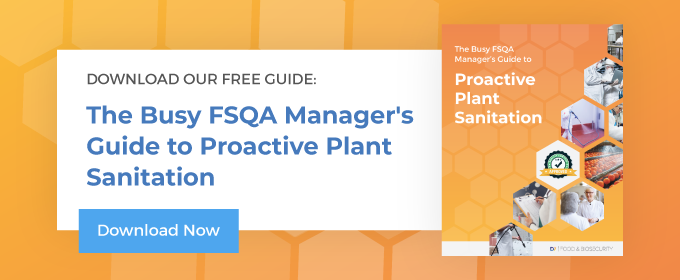
Maintaining a safe level of bacteria and controlling odors in a food processing facility often requires a multi-pronged approach, especially for preventing biofilm formation. Rotating chemicals and using different application methods are two ways to keep unwanted bacteria and odors at bay. In addition to sprays and foams that remove bacteria from surfaces, fogging is another application method that many FSQA managers employ in facilities to address odors, especially those that come from bacteria in areas that are difficult to reach.
4-Way Fogger Overview
The 4-way fogger is a free-standing system that uses compressed air and venturi action to deliver fogged chemicals with medium-sized particles. The range is up to 25 feet in four directions, effectively covering up to 2,500 square feet in a facility. An adjustable valve allows you to control the density of the fogged particles, so you can create a lighter or heavier application as desired.
Simply attach the fogger to an air supply and turn it on to begin application. Because the system creates fogged particles that permeate the entire space, personnel cannot operate in the area during treatment unless they are wearing appropriate safety equipment.
4-Way Fogger Benefits
Whether used on its own to help control odors or in combination with other application methods for sanitizing chemicals, the 4-way fogger offers several benefits to FSQA managers.
Minimal Personnel Required
When using a chemical fogger, the machine does all the work after it has been set up and started. After cleaning all surfaces in preparation for sanitation and applying a sanitizing foam that brings bacteria to safe levels, the fogger can be used to help ensure that the sanitizer reaches all areas in the facility to address odors. It can also be used on its own between sanitizing for deodorization. For biofilm treatment, using a chemical like D7 foam means that no mechanical action is required. When followed by fogged D7, any odors that were left behind also get addressed. This helps free up even more personnel time and might even allow you to have smaller sanitation crews. You can connect the system to 1-, 2.5-, and 5-gallon tanks depending on the size of the area you are treating and how much chemical needs to be applied.
Reaches Hidden Areas
Atomized chemicals are able to reach areas that are often overlooked, enabling more complete coverage. The particles can reach the spaces between equipment and the nooks and crannies in a facility that are not as visible. This contributes to better odor control in a facility, often with less manpower.
No Dilution Required
Because the chemicals are fogged into the air, no dilution with water is required during application. This means that chemicals are applied at the correct concentration every time.
Low-Profile Equipment
The 4-way fogger is just 67 inches tall and has a small footprint, making it easy to store when not in use. It is also lightweight and easy to move to different locations throughout a facility. As long as you have a source of compressed air nearby, you can use the fogger.
Use Fogged D7 in Your Facility
Having multiple types of equipment available in your arsenal against food-borne bacteria is a smart way to avoid costly outbreaks and food recalls. In addition to bringing bacteria to safe levels through the application of foam or spray, you can cost-effectively remove odors with an fogger. Using a 4-way fogger is an efficient way to apply deodorizing chemicals in a facility, especially when combined with other approaches, such as sanitizing foam. To learn more methods and best practices for maintaining a clean and sanitary food processing facility, read The Busy FSQA Manager’s Guide to Proactive Plant Sanitation.

